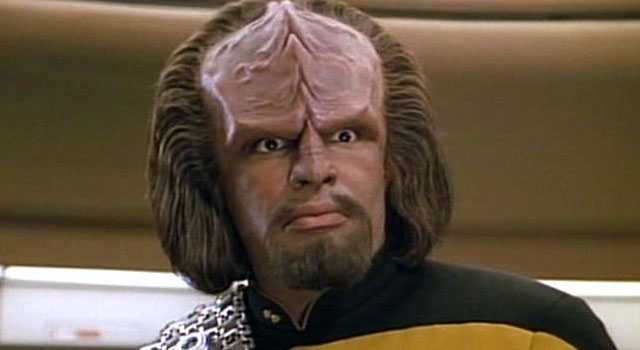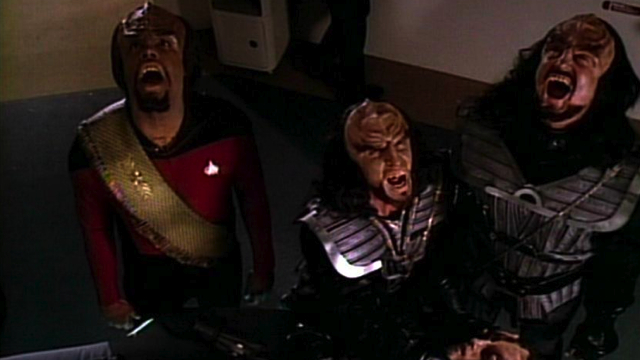How was the Klingon language developed?
By all accepted definitions of the term, Klingon qualifies as a real language. It is the structured written and verbal means by which Klingons communicate in the fictional Star Trek (1966) universe. It may not be as extensive and complete as English or Spanish, but Klingon is realized enough that fans can engage in full conversations, works of literature have been translated into Klingon, Bing offers it as a choice in their online language translation tool, and, in all likelihood, this summary of its development could be written in Klingon.
chovoqbe’‘a’? yIlegh! (Don’t believe me? Take a look.)

The Big Bang Theory (2006) likes to use Sheldon (Jim Parsons) and Leonard’s (Johnny Galecki) fluent Klingon as the brunt of endless jokes, but the reality is that thanks to the attention of linguist Marc Okrand, Klingon is as sophisticated and complex a language as any other, requiring as much time and study to learn as any “real” Earth language. In 1979, the original Star Trek: The Motion Picture film opened with a few spoken lines of Klingon written by James Doohan, the actor who played Scotty. For Star Trek III: The Search For Spock (1984), Klingons were going to be the antagonistic force in the picture, and director Leonard Nimoy wanted them to do more than speak random gibberish. Okrand was hired to expand the language into something legitimate. He had previously worked on Star Trek II: The Wrath of Khan (1982), for which he came up with a handful of lines of Vulcan dialogue that were dubbed into an already-filmed scene. The demands put upon him for Klingon’s conception were much more elaborate.
Okrand took the six lines spoken in Star Trek: The Motion Picture and used them as his template. He established syllables, imposed grammatical structure, imagined patterns of speech, and documented it all for consistency as he pushed forward. This created a real linguistic template upon which new vocabulary could, and would, be created. Klingon doesn’t involve simple vocabulary substitutions like the Nadsat language in A Clockwork Orange (1972), and isn’t simply nonsense like the ramblings of Ewoks. It has more intricacy to its construction.

Slate explains, “Klingon sentence structure is about as complex as it gets. Most people are familiar with the idea that verb endings can indicate person and number. In Spanish, the -osuffix on a verb like hablar (to speak) indicates a first-person singular subject (hablo—I speak) while the -amos suffix indicates a first-person plural subject (hablamos—we speak). But Klingon uses prefixes rather than suffixes for such purposes, and instead of having six or seven of them, like most romance languages, it has 29. There are so many because they indicate not only the person and number of the subject (who is doing) but also of the object (whom it is being done to). Klingon also has a large set of suffixes. Klingon has 36 verb suffixes and 26 noun suffixes that express everything from negation to causality to possession to how willing a speaker is to vouch for the accuracy of what he says. By piling on these suffixes, one after the other, you can pack a lot of meaning on to a single word in Klingon—words like nuHegh’eghrupqa’moHlaHbe’law’lI’neS, which translates roughly to: They are apparently unable to cause us to prepare to resume honorable suicide (in progress).”
Okrand intentionally made the language challenging and subversive of the way languages are typically structured. Klingon utilizes an object-verb-subject word order, which is uncommon in traditional languages, and he actively tried to make it sound like nothing present in the real world. He told The Wall Street Journal, “You can’t help being influenced by what you know, which (for me) was a bit of Spanish, French and American Indian. I also knew Southeast Asian languages. I’d be writing something and suddenly realize that it sounded like Navajo. I’d stop and make sure the next thing sounded as different as it could possibly be. I expanded the language for the fifth and sixth film and wrote a book called ‘The Klingon Dictionary’ in 1992.” That dictionary is now the authoritative document on Klingon language and a quarter-million copies have been sold.
A Klingon Language Institute was created in 1992, a still-active and thriving group that serves to promote and support the ever-popular hobby of learning Klingon. The Institute even publishes a quarterly journal. In Star Trek VI: The Undiscovered Country (1991), Spock (Leonard Nimoy) makes a statement that “you can’t appreciate Hamlet until you’ve read it in Klingon.” Go figure, fans from the KLI did the translation, and the book was published in 1996.
Much of Klingon’s development has been done by the KLI and its various scholars, compounding upon the framework built by Okrand. The language originally included only those words and phrases required by the Star Trek III script. But, as with any structure-based form of communication, new vocabulary can be created using established rules and format. As such, the Klingon language now contains thousands of words.
The Klingon writing system, pIqaD, was then developed. It is unique in its own complexities. Okrand has voiced his complements to those who created the system which does not rely on English letters, successfully deciding Klingon has an alphabet and is not a syllabary.

For those wanting to learn more about Okrand’s creation of the Klingon language, he put together a full YouTube video explaining it all in depth. It is a good watch for anyone interested not just in Klingon, but in linguistic composition in general:
With the sustained popularity of Star Trek, it is likely that Klingon will continue to be studied and expanded.

